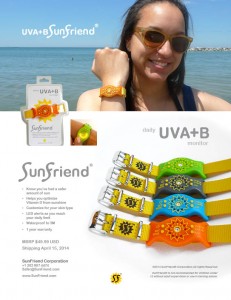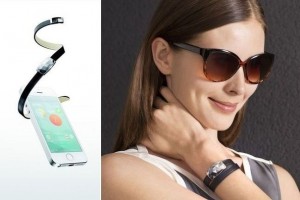With all the fast-paced advances in smart phones, computers and applied technology, it makes sense that we’re seeing the development of devices designed to save our skin. Not meant to replace  sunscreen, the purpose of these monitors is purely to alert individuals who are spending time outdoors – especially those who may have particular skin concerns such as fair or photodamaged skin – when she or he should seek shade.
sunscreen, the purpose of these monitors is purely to alert individuals who are spending time outdoors – especially those who may have particular skin concerns such as fair or photodamaged skin – when she or he should seek shade.
The earliest devices were portable, sometimes with a wrist strap or waist clip, much like the original pedometer. The Oregon Scientific Portable UV Monitor (now discontinued) was one of the more popular ones, monitoring the UV index and temperature, and then calculating recommended exposure time based on your skin type, SPF and UV levels.
Since then two types of personalized UV monitoring devices have emerged: smart phone apps and wearables. While the former is easy and affordable to try out, the latter is not. At least, not yet.
Wearables
SunFriend Personal UV Monitor was the first wearable sun intake monitor on the market. Customizable, waterproof and durable, its “NASA-inspired technology” reads the UV index and decides, based on your skin type, when you have reached your sun exposure limit. Available in four colours, the SunFriend costs approximately $50 US.
 Receiving fairly favourable reviews online is Netatmo’s June sun-monitoring bracelet, which arrived on the scene in 2014. Beautifully modern in design, this stylish piece of jewellery is a sun sensor that measures how much UV exposure you’re receiving, in order to protect you from getting a sunburn and “prevent premature skin aging”. It considers your skin type and UV exposure to create a ‘daily sun dose’ guideline. However, it only sends you alerts if connected to a newer iPhone via Bluetooth – and costs $129 US.
Receiving fairly favourable reviews online is Netatmo’s June sun-monitoring bracelet, which arrived on the scene in 2014. Beautifully modern in design, this stylish piece of jewellery is a sun sensor that measures how much UV exposure you’re receiving, in order to protect you from getting a sunburn and “prevent premature skin aging”. It considers your skin type and UV exposure to create a ‘daily sun dose’ guideline. However, it only sends you alerts if connected to a newer iPhone via Bluetooth – and costs $129 US.
Apps
There are several smartphone apps to help monitor sun exposure. Some start with just the basics, such as a UV index viewer for your location, while others incorporate personal data and utilize mobile technology to deliver fully customized sun exposure alerts.
For example, SunIQ ($1.60) determines how long you can stay in the sun based on your skin type, your location, your SPF and the current UV index, using technology such as wifi, GPS and push notifications. Reminders and alerts can be programmed to appear, keeping you hydrated and re-applying sunscreen.
iTanSmart ($2.29) claims to be the most advanced and featured-filled app, telling you when to re-apply sunscreen and when to take shelter. It also provides “updates on vitamin D production while you relax and listen to your iTunes” (obviously targeted to dedicated sun tanners). To do this, it takes five factors into account: current UV index, your environment, time of day, skin type and SPF type.
The Verdict
We asked Dr. Rivers for his opinion on these products, to find out whether or not they are worth our attention, time or money. Dr. Rivers notes, “Although these devices sound interesting, they have not been subjected to rigorous scientific research and, therefore, should be used with caution.”
Indeed, the apps are inexpensive and their presentation of facts is eye-catching and convenient, but it’s best to not to rely on a high-tech device. If you properly follow general sun safety guidelines (e.g. limit the amount of time you spend in the direct sun, especially when the sun’s rays are most intense), there should be no need for a UV exposure monitor.